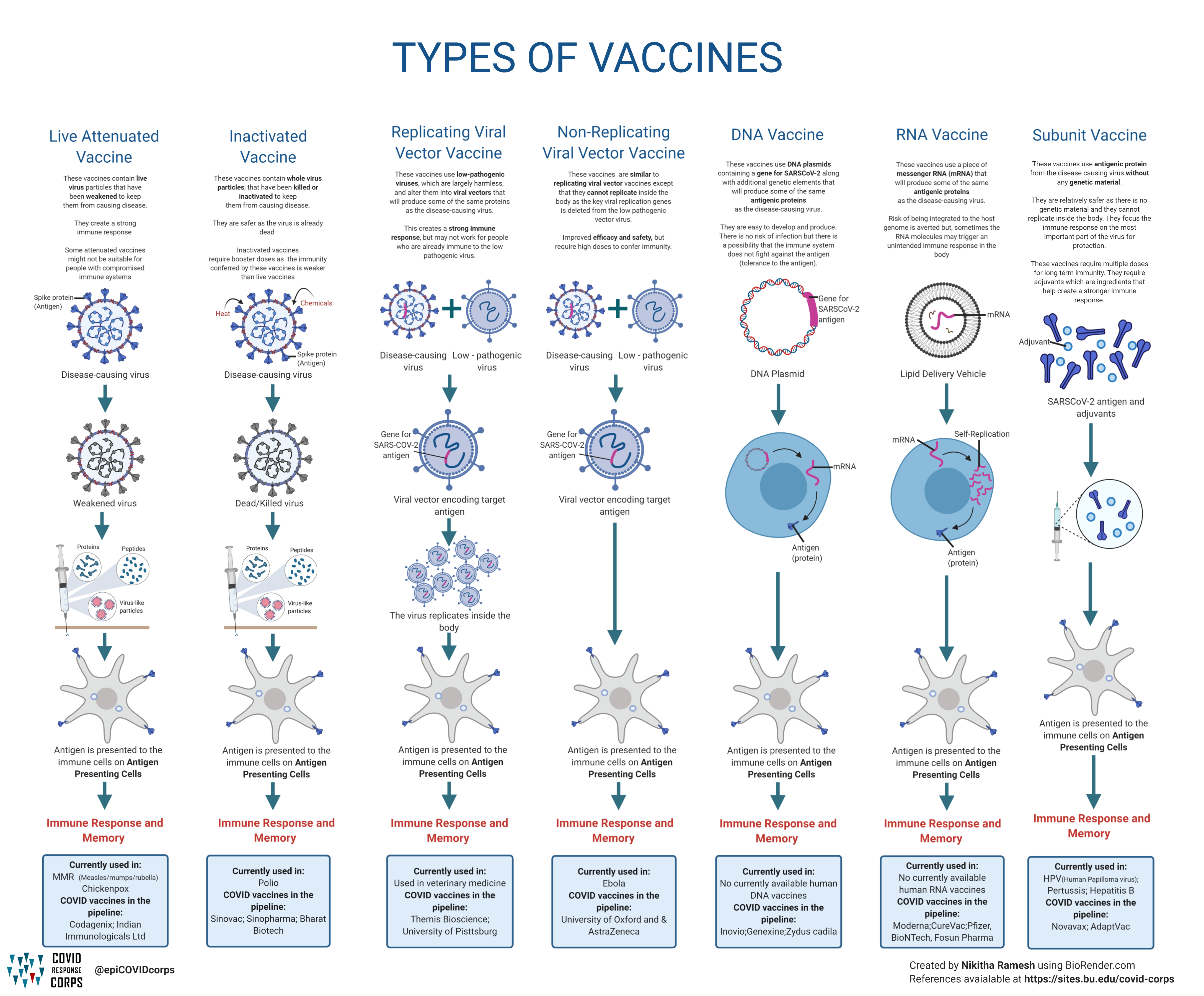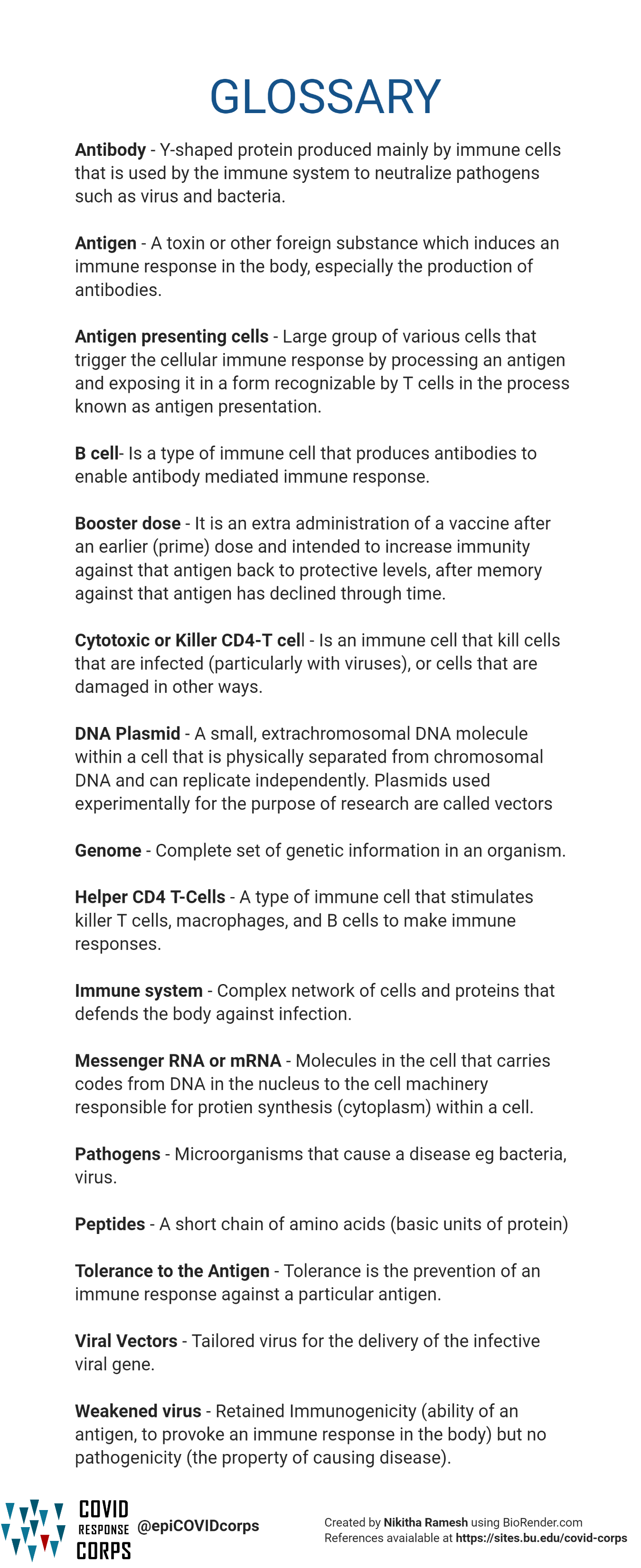Types of Vaccines Infographics
Nikitha Ramesh
Mentor: Dr. Ellie Murray
A set of infographics to explain the basics of immune response by the body and the different kinds of vaccines that are being developed around the world to fight against the corona pandemic work. The vaccine type infographic places the vaccine types side-by-side to highlight how they are similar and how they differ. Also included is a glossary of terms document to compliment both the immune response and vaccine types infographics.
Basics of the human immune response

Image: Disease-causing virus
Image: Virus enters body replicates inside the cells
Image: Antigen-presenting cells
- Take antigens from the infecting viruses and present them to immune cells.
Image: Helper CD4+ T-cells
- Recognize the antigen
Cell mediated immunity
Image: Cytotoxic or “killer” CD8+ T-cells
- Produce and release cytotoxins, which kill infected cells.
Image: Infected cell
Image: Destroyed infected cell
Antibody Mediated immunity
Image: B cells
- Produce antibodies, which can neutralize virus.
Image: Antibodies
Image: Antibodies attacking virus in the cell.
Types of vaccines

1. Live Attenuated Vaccines
These vaccines contain live virus particles that have been weakened to keep them from causing disease. They create a strong immune response. Some attenuated vaccines might not be suitable for people with compromised immune systems.
Image: Disease-causing virus
Image: Weakened virus
Image: Vaccine
Image: Antigen-presenting cells
- Take antigens from the infecting viruses and present them to immune cells.
Immune Response and Memory
Currently used in:
- MMR (Measles/mumps/rubella)
- Chickenpox
- COVID vaccines in the pipeline:
- Codagenix; Indian Immunologicals Ltd
2. Inactivated Vaccine
These vaccines contain whole virus particles, that have been killed or inactivated to keep
them from causing disease. They are safer as the virus is already dead. Inactivated vaccines
require booster doses as the immunity conferred by these vaccines is weaker than live vaccines.
Image: Disease-causing virus
Image: Dead/Killed virus
Image: Vaccine
Image: Antigen-presenting cells
- Take antigens from the infecting viruses and present them to immune cells.
Immune Response and Memory
Currently used in:
- Polio
COVID vaccines in the pipeline:
- Sinovac
- Sinopharma
- Bharat Biotech
3. Replicating Viral Vector Vaccine
These vaccines use low-pathogenic viruses, which are largely harmless, and alter them into viral vectors that will produce some of the same proteins as the disease-causing virus. This creates a strong immune response but may not work for people who are already immune to the low pathogenic virus.
Image: Disease-causing virus + Low – pathogenic virus
Image: Viral vector encoding target antigen
Image: The virus replicates inside the body
Image: Antigen-presenting cells
- Take antigens from the infecting viruses and present them to immune cells.
Immune Response and Memory
Currently used in:
- Used in veterinary medicine
COVID vaccines in the pipeline:
- Themis Bioscience
- University of Pittsburg
4. Non-Replicating Viral Vector Vaccine
These vaccines are similar to replicating viral vector vaccines except that they cannot replicate inside the body as the key viral replication genes is deleted from the low pathogenic vector virus. Improved efficacy and safety but require high doses to confer immunity.
Image: Disease-causing virus + Low – pathogenic virus
Image: Viral vector encoding target antigen
Image: Antigen-presenting cells
- Take antigens from the infecting viruses and present them to immune cells.
Immune Response and Memory
Currently used in:
- Ebola
COVID vaccines in the pipeline:
- University of Oxford and & AstraZeneca
5. DNA Vaccine
These vaccines use DNA plasmids containing a gene for SARSCoV-2 along with additional genetic elements that will produce some of the same antigenic proteins as the disease-causing virus. They are easy to develop and produce. There is no risk of infection but there is a possibility that the immune system does not fight against the antigen (tolerance to the antigen).
Image: DNA Plasmid with gene for SARS-CoV2 antigen
Image: DNA to mRNA to Antigen (protein) within a cell
Image: Antigen-presenting cells
- Take antigens from the infecting viruses and present them to immune cells.
Immune Response and Memory
Currently used in:
- No currently available human DNA vaccines
COVID vaccines in the pipeline:
- Inovio
- Genexine
- Zydus cadila
6. RNA Vaccine
These vaccines use a piece of messenger RNA (mRNA) that will produce some of the same antigenic proteins as the disease-causing virus. Risk of being integrated to the host genome is averted but, sometimes the RNA molecules may trigger an unintended immune response in the body.
Image: Lipid Delivery Vehicle with mRNA
Image: mRNA to Self-Replication to Antigen (protein)
Image: Antigen-presenting cells
- Take antigens from the infecting viruses and present them to immune cells.
Immune Response and Memory
Currently used in:
- No currently available human RNA vaccines
COVID vaccines in the pipeline:
- Moderna
- CureVac
- Pfizer
- BioNTech
- Fosun Pharma
7. Subunit Vaccine
These vaccines use antigenic protein from the disease-causing virus without any genetic material. They are relatively safer as there is no genetic material and they cannot replicate inside the body. They focus the immune response on the most important part of the virus for protection. These vaccines require multiple doses for long term immunity. They require adjuvants which are ingredients that help create a stronger immune response.
Image: SARSCoV-2 antigen and adjuvants
Image: Vaccine
Image: Antigen-presenting cells
- Take antigens from the infecting viruses and present them to immune cells.
Immune Response and Memory
Currently used in:
- HPV (Human Papilloma virus)
- Pertussis
- Hepatitis B
COVID vaccines in the pipeline:
- Novavax
- AdaptVac
Glossary of terms
